
This blog has fallen quiet over the past month or two while I’ve been working on what turned out to be a bit of a large-scale project. While it doesn’t directly have much to do with “molecular gastronomy” per se, it was still incredibly interesting for me, and brought to bear several things I’ve learned over the course of this project. Hopefully talking about it will be (at most) helpful or (at least) moderately interesting.
Several months ago, I decided to try catering an event. The conditions of the event:
- It would be for about 55 people, one of which was vegetarian and 8 of which were children.
- It would be held in Kentucky, in mid-October.
- It would take place in a barn, with no cooking facilities.
- I would be getting married on the same day.
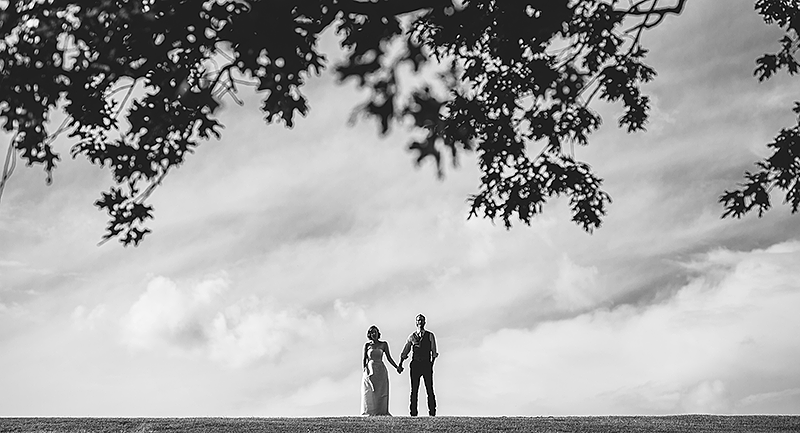
When Sarah and I were looking for a wedding venue about a year ago, we were visiting my parents on the farm I grew up on in KY. At one point we were walking around the woods behind our house, debating the possibility of San Fran (where we currently live, but where we don’t have any super-sentimental attachments other than our friends) or New Zealand (where we have heaps and heaps of super-sentimental attachments, but the burden of travel on our families would be tough). I paused to breathe the crisp December air in deeply. The forest was largely silent, and the damp smell of leaves has always been intoxicating to me. I recalled reading about how, in the Fall last year, Alinea lined their entryway with leaves and pumpkins, seeking to provide a more-immersive seasonal experience for guests. Things clicked into place immediately in my head: “Why don’t we do this?” I asked. Sarah looked at me quizzically and skeptically. “This, just like this” I said, gesturing at the woods. “What if we invite all our friends here, and we ask them to walk through these woods, and get married under…that tree over there.” I pointed to a lone walnut tree that sits in a clearing through the woods behind our house.
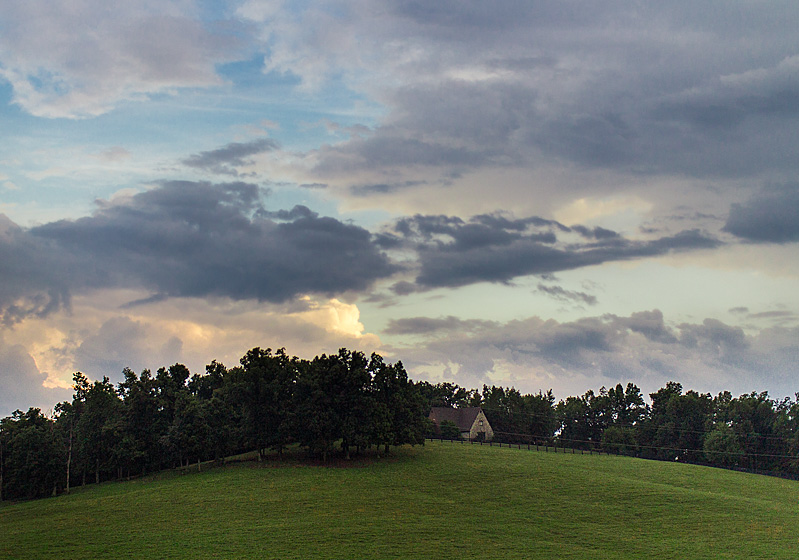
“Where would we have a reception?” Sarah asked.
We walked around the farm to my grandfather’s barn, a barn that’s been on the property for over 100 years. It’s dilapidated and weathered and beautiful. It’s split into stalls that house farming implements, feed for cattle, and odd storage of stuff from my grandparents’ estate. The loft of the barn used to store hay; there’s a large pulley system that’s rusted and awesome hovering overhead, and it smells sweet and moist and…like a barn. I took Sarah up to it, and we eyed it carefully. The barn would need a lot of work, but Sarah was able to see past it to what my heart was seeing: a special place that was irreplicable, small, and very personal. I wanted everyone to feel not just the day, but the deep roots of our family and our history. I wanted to do Alinea’s hallway trick to the Nth degree.

One of my favorite things to do when I come back to KY to visit family is to cook with them. My favorite mode of this is my dad’s grill; he fires it up and he, my brother-in-law Aaron, and I stand around it sipping bourbon and chatting. My sisters and mom come out from time to time to ask us how it’s going or how much longer it will be, but really what they’re doing is sniffing the smoky smell and enjoying the enforced exercising of patience and sensuality that grilling demands.
I wanted this on a larger scale for our wedding day. I wanted all of our friends and family to be sipping drinks and sitting or standing around on the big day, swapping stories, watching the kids run around and play, and relying on the preparation of a communal meal to force us to slow down together. I wanted people perfumed head to toe with the incredible scent of applewood smoke and caramelized brown sugar, and I wanted them to bug me every few minutes for a peek at whatever was cooking. I wanted things to move slowly and deliberately.
Now, I’ve never cooked a meal for anything more than 12 people at once, and you may recall the last time I did this it went less awesomely than I wanted. Cooking for 55 people was a daunting proposition to say the least. Sarah and I collapsed onto our menu pretty quickly though: we both love southern BBQ, and it lends itself well to large communal meals like what we envisioned at our reception. After some discussion, we landed on:
- Brisket
- Pulled Pork
- Ribs
- Pickled Vegetables
- Cornbread
- Baked Beans
- Coleslaw
I started planning several months in advance. One of my first moves was consulting with the chefs in the kitchen at work; they knew how to deal with large numbers (they cook for 1000 people each day), so I asked them for estimates for the hero ingredients for each dish. We settled on
- 20lbs brisket
- 25lbs ribs (~2 ribs per person, ~12 ribs per rack)
- 25lbs pork shoulder
- 10lbs dried beans
- 10 heads cabbage
These figures roughly account for around 1lb of meat per person inclusive of shrinkage, predicated on the assumption that people will want to try more than one protein, that pork is generally favored, and that people will likely over-portion themselves (since we would be serving food family-style). Working from these starting points, I began building recipes around them and scaling up auxiliary ingredients appropriately. The cornbread was based on a recipe provided by my friend Francisco’s partner Deanie, who (I mentioned in an earlier post) is a Michelin-starred chef who has worked at the likes of Manresa, Ubuntu, and Coi. We wanted to serve pickled vegetables in small pint Ball jars, so that served as my reference point for figuring out how much pickling juice/veggies I would need.
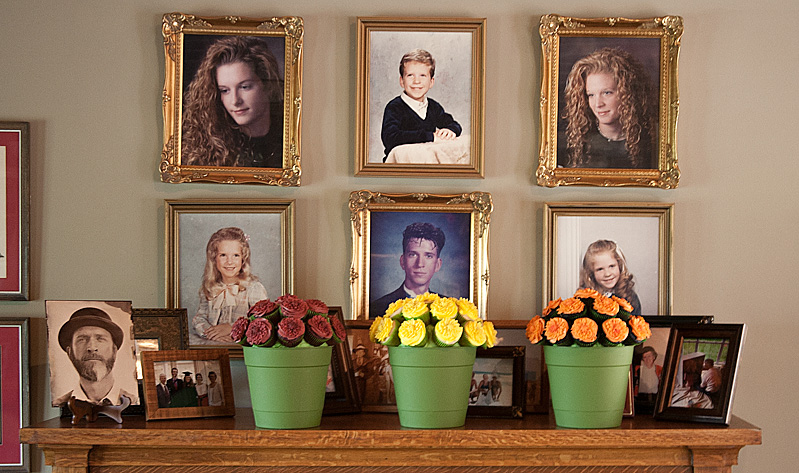
If you’re gonna make BBQ, you obviously need some BBQ sauce. Several months ago I spent a full weekend making about a dozen different BBQ sauces, keeping tasting and cooking notes as I went. I made some pulled pork and Sarah and I sat down to the awful job of eating our way through each sauce to choose and hone what we wanted. We landed on a mustard-based Carolina sauce, a Bourbon-based sauce, and a traditional Kansas City style sauce as our top choices. Kansas City-style sauces are what most people imagine when they think of the quintessential BBQ sauce: sweet, tangy, maybe a bit of smoke. KC Masterpiece is a good example of this style. My Bourbon sauce included orange blossom water, citrus peel, and chocolate bitters…a nod towards my obsession with Old Fashioneds. The mustard sauce was made with dijon, Allagash Curieux, and spices.
I knew the week’s schedule leading up to the wedding would be very busy with other cooking tasks, so I figured I could pre-make sauces pretty safely (and, in fact, they were likely to get better with some age on them). One weekend about a month before the wedding, Sarah flew to Chicago for a bachelorette party, leaving me space and time in the kitchen to scale up our recipes to yield enough sauce for a bottle of each flavor on each of the 8 tables we’d have at the reception. I chose some sauce bottles from Specialty Bottle, using their capacity as my guide for how to scale my sauce recipes. The Bourbon Sauce recipe involved cooking down about 3 liters of Kentucky bourbon; turns out that this is a bit tricky to do in a small apartment. The alcohol fumes filled the space pretty handily, leaving me choking and running for open windows as the bourbon reduced. I cooked each sauce for several hours, and tested each with a pH meter before bottling to ensure that they were acidic enough to stay safely-preserved for the time leading up to the wedding (anything below 4.6 will kill botulism spores and generally prevent growth of anything oogy). I also checked the caps as the bottles cooled to ensure they were safely sealed (they bow inwards, an indication that the cooling process created a vacuum inside the bottle), then I shipped them in a box to Kentucky for my parents to hold them until we got there. I reserved two bottles in San Fran to serve as monitoring samples; if they lasted until we were ready to fly to KY, I’d know I didn’t need to remake any of them.
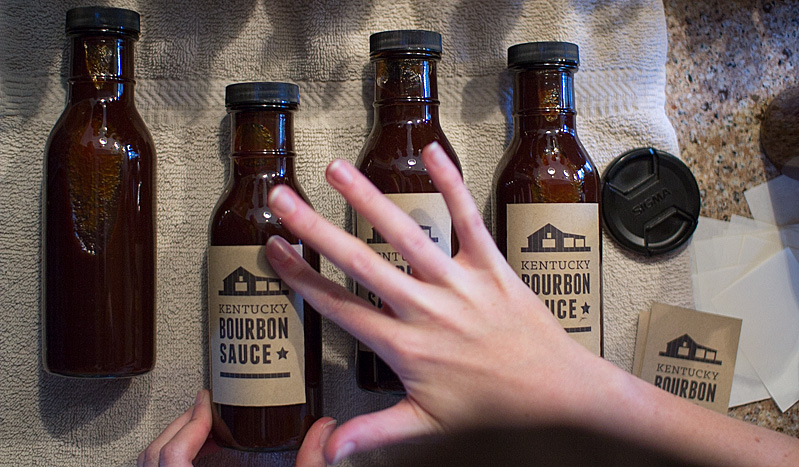

I also mixed up several rubs to use for smoking the meats I intended to cook; one was a savory mixture of salt, smoked paprika, pepper, and coffee for use on the brisket. Another was a mixture of paprika, salt, garlic powder, and some other spices for ribs. And finally, Sarah’s favorite: a combination of brown sugar, smoked paprika, and cinnamon for the pulled pork. I vacuum-packaged each of these and included them with the sauces to KY.

We flew from SF to KY a week before the wedding to help prepare for it. Sarah and my parents focused on finalizing the barn while I worked on preparing all the food we’d be eating. I’d worked with the chefs at work to establish a reasonable cooking schedule that would maximize freshness while still allowing room for unexpected problems.
Sarah, my parents and I made a “Reminders” list on our iPhones. The latest iCloud updates allow for shared Reminders lists; we leveraged this to build a master grocery shopping list that we could all access and modify simultaneously. We then split up and went on several shopping trips to buy all the ingredients we’d be needing.
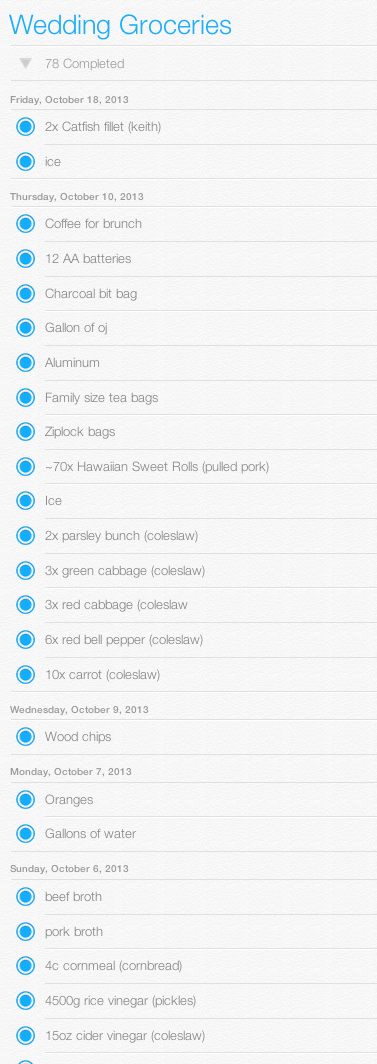
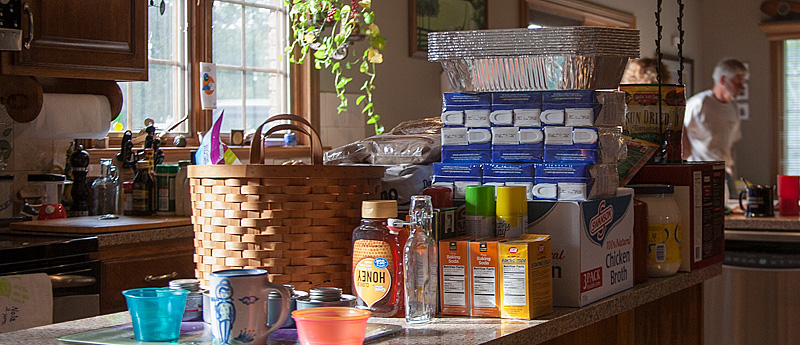
We also had a master Google Docs spreadsheet on which I’d built a schedule for cooking and a list of what ingredients I’d need.
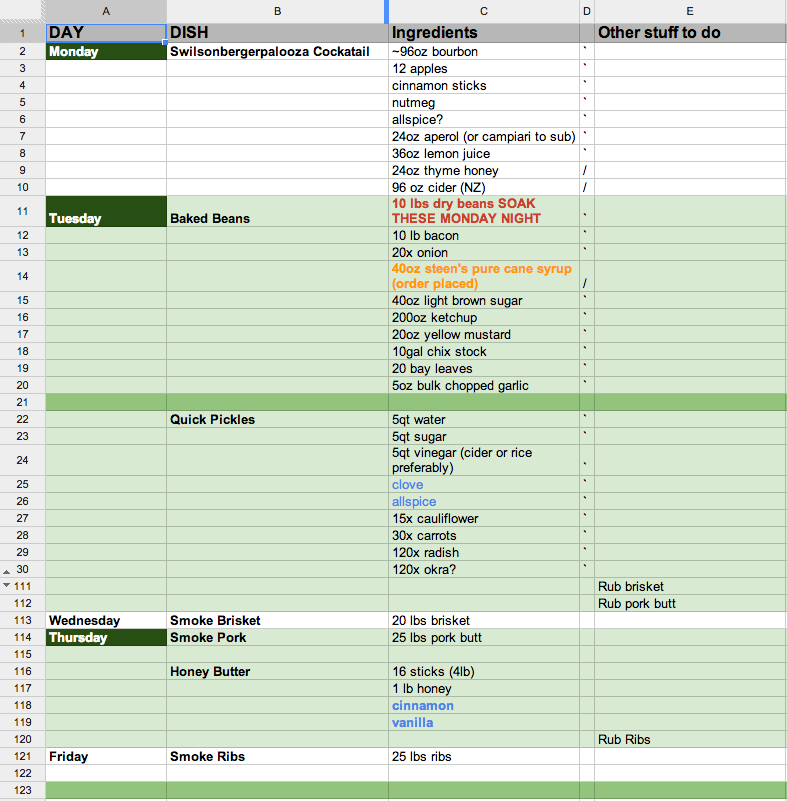
On Monday, I began by making quick pickles. Alinea consistently pickles things in the cookbook using a mixture of equal parts sugar, water, and vinegar. One can ease back on the sugar and use a ‘softer’ vinegar like rice vinegar to mellow out this mixture. Rice vinegar is tough to find in bulk in Kentucky, so I opted for cider vinegar. I had a hard time imaging what quantities of vegetables I needed to fill 60 pint glasses, so I took a stab in the dark that was maybe 80% accurate.

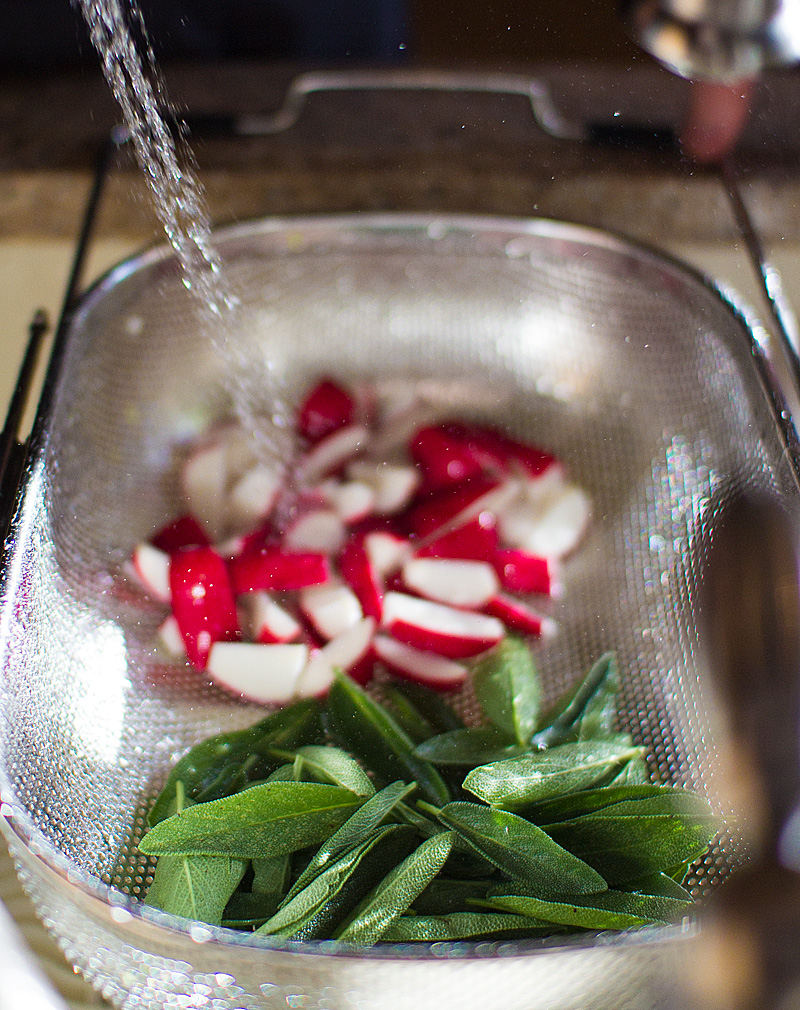
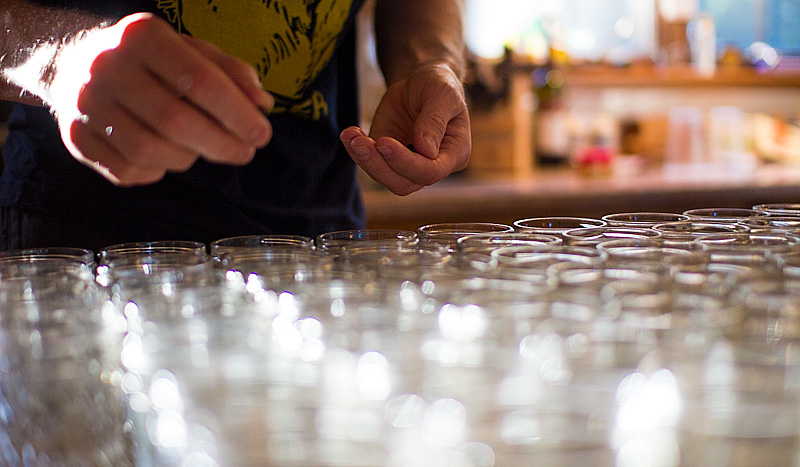
The quick pickles included:
- black peppercorns
- allspice berries
- coriander seeds
- sage leaves from my mom’s garden
- cloves
- cauliflower florets
- carrot spears
- radish quarters and slices
- okra pods
- broccoli florets
- green beans
- onion slices
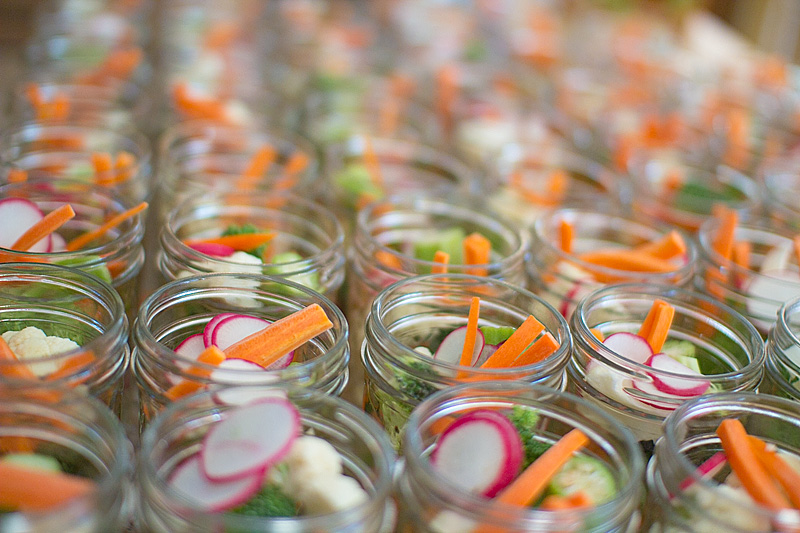
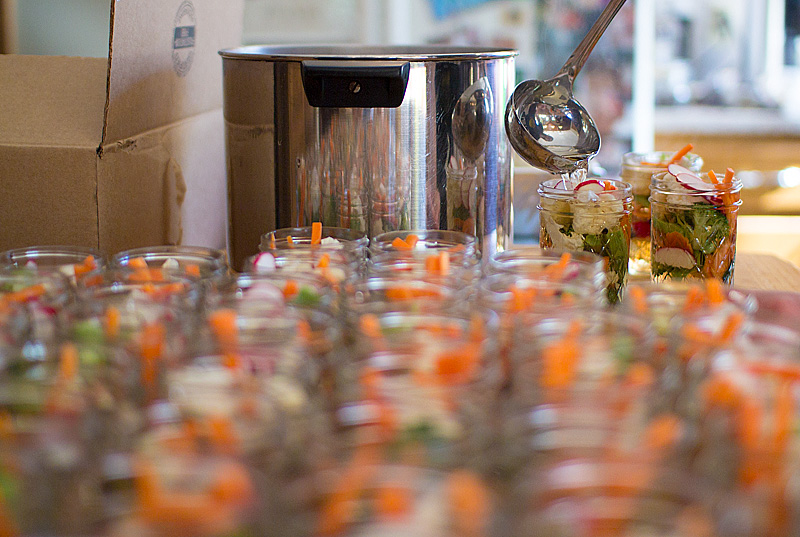
I also got to work on our cocktails. Sarah and I wanted each guest to take an autumnal stroll through the woods on our farm down to our aforementioned Hitchin’ Tree for our ceremony. We designed a cocktail to accompany them along the way; we spent a weekend experimenting with moonshine, champagne, elderflower, apples, blueberries, pumpkins, and various other flavors we have a particular affinity for, emotional connection to, or seasonal awareness of. We landed on something revolving around apple-infused Maker’s Mark, New Zealand hard cider, and Thyme Honey from NZ…a nod to the two places we consider home. I found a half-carboy into which I poured a few liters of Maker’s Mark, slices from about 12 apples, some nutmeg, allspice, and cinnamon sticks. This — after a week or so — would yield something akin to apple pie-flavored bourbon.
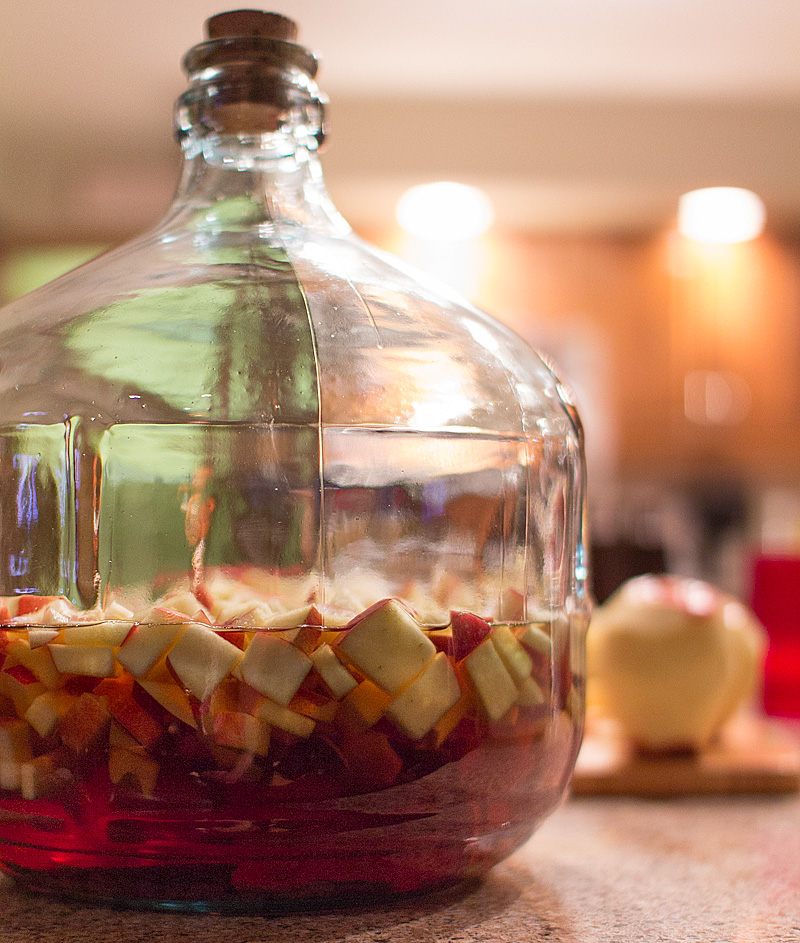
On Monday night, I sorted and rinsed 10lbs of dried navy beans, then left these to soak overnight.
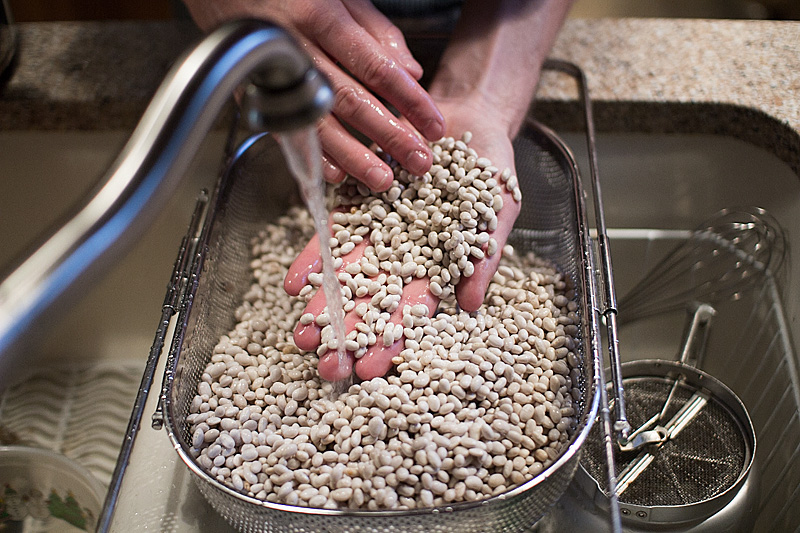
10lbs of beans, it turns out, is an absurd amount of beans. My base recipe calls for 1lb of beans, and yields about 8 servings. Anticipating people wanting seconds or taking larger scoops than others from the serving bowls at dinner, I scaled by 10. The base recipe also calls for 1 gallon of chicken stock in which to simmer the beans, so I again scaled this up by 10 (!). I roughly separated the beans into two batches of unequal sizes, and went about cooking them with the onions, cane syrup, ketchup, mustard, and spices that they’re meant to simmer with, but quickly realized that neither of my vessels could hold anywhere close to 5 gallons. So I figured I’d cook them and just replenish the stock as needed until I’d made it through all 10 gallons, figuring the beans would just cook more slowly that way.

This was an awful assumption. The beans had plenty of moisture to absorb from the syrup, sugar, and ketchup they simmered in absent of the full amount of chicken stock that was meant to be present, cooking as fast as they normally would but becoming much sweeter than I wanted. Wrangling these massive batches of beans was task enough in and of itself, but at one point I managed to clog the sink with undigested onions and their skins that our garbage disposal couldn’t handle (lesson: don’t try washing onion skins down the sink). I had to ask Dad to help me unclog their sink, which was tricky because the plumbing under the sink doesn’t have removable sections, so we had to cut the pipe out completely. This left me with no running water and a giant mess in the kitchen while trying to deal with my bean problem.
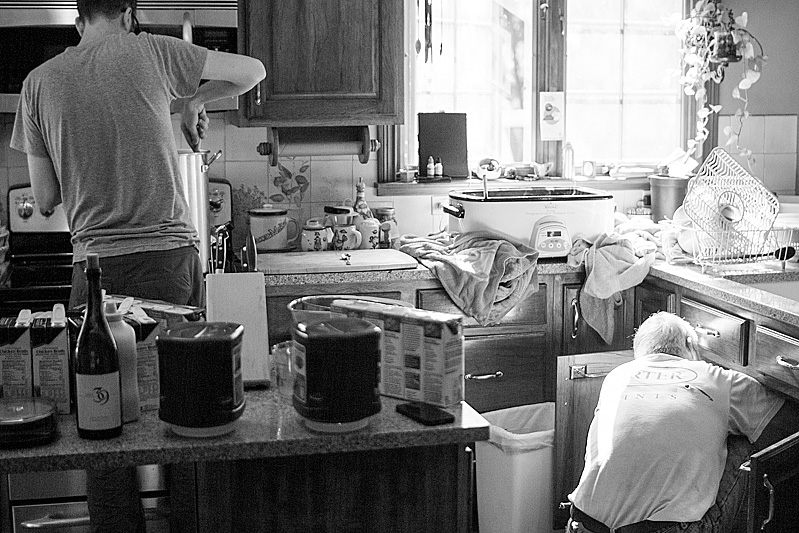
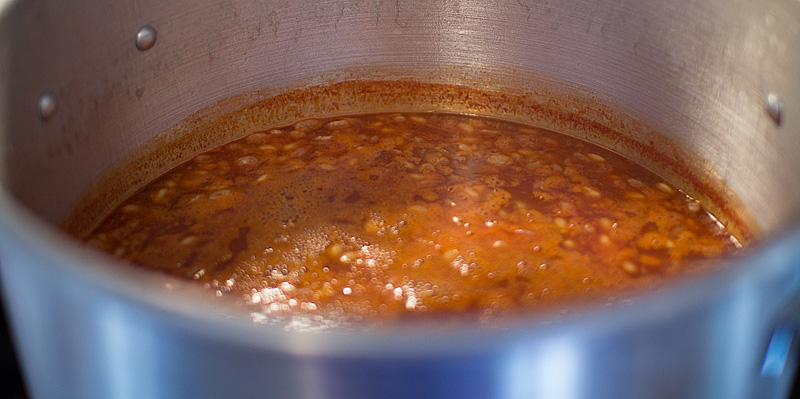
In the middle of this, we got a phone call from a neighbor that someone had had a heart attack on the highway while driving in front of our house, and had run off the road and through the front fence of the farm. I am not making this up. We had to both drop everything, run to the bottom of the hill our house sits on, and (after two ambulances had come to retrieve the ailing motorist, and a tow truck had hauled off the car) repair a fence lest our cattle escape out onto the highway. This is decidedly not a challenge I’d encountered at any point in this cooking project before now.

Fence repaired, back up at the house I needed to regroup after such a mess of a day. I wasn’t happy with the beans at all, so I decided to scrap them, rebuy what ingredients I needed to, and remake them the next day. Sarah and I ran into town to stock back up at the only grocery store in town, a Super Wal-Mart. The upside was being able to re-calibrate my recipe scale to something more reasonable (10lbs was way too much, turns out). When we got home, I re-rinsed, re-sorted, and re-soaked the beans overnight.
Wednesday morning was my first scheduled smoke. I rose early to get the beans re-started; I decided rather than trying to cook them all at once, I would cook individual un-scaled recipe sizes in series until I had enough. This would 1) let me control the final scale of the batch and 2) allow me to adjust as I went. The beans took about 4 hours per batch to cook, so I figured worst case I could make it through 3 rounds in the day to complete them all. I rounded up every stock pot in the house, cooking 4 portions simultaneously. Obviously inefficient, this nevertheless behaved way better. The evaporation rates of the stock behaved more like what I expect; turns out evaporation rates are way important when working with recipes like this.
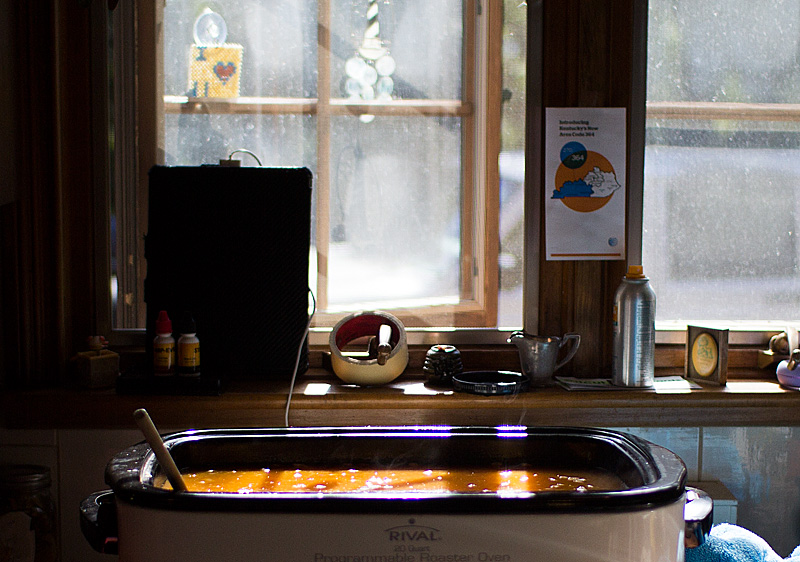
Beans a-simmer, I turned my attention to the smoker, and the brisket I’d be cooking. Brisket is sort of the pectoral muscle of a cow; it’s very tough and cheap and lends itself to long cooking to break up the thickly-interwoven collagen in the meat. I’d rubbed the brisket with my coffee rub the night before and wrapped it in plastic wrap to let it sit overnight. A rub helps season meat, add flavor, and aids in the formation of a “bark”: the crisp outer skin that forms when slow-cooking meat over low heat. This bark is sweet and savory and basically like meat candy.
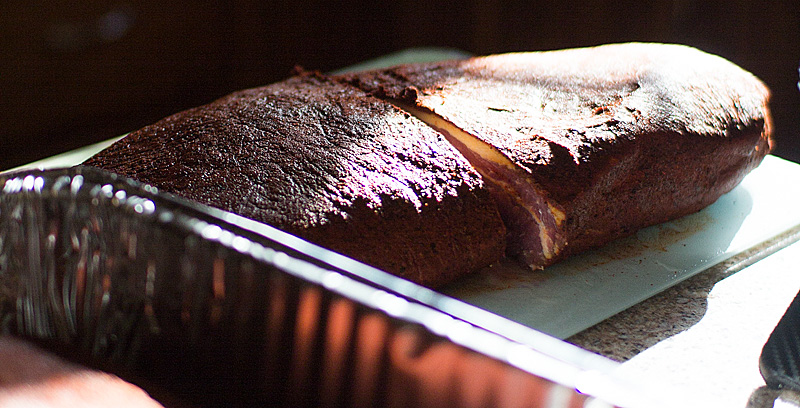
Now, I would be remiss if I didn’t talk a little about the craft of slow-cooking meat. One generally slow-cooks tough meats that are woven with tough collagen that turns elastic and unpalatable under fast cooking conditions. Braising or stewing are common ways of dealing with these meats; low temperatures in an enclosed, humid environment render the collagen into gelatin and turn the meat into a tender, juicy delight that melts at the slightest touch of a fork. The introduction and growing ubiquitousness of sous vide cooking techniques offer consistency and control when slow-cooking meat. All of these methods are generally pretty rad because they offer one common element: control. A household oven or an immersion circulator are “fire and forget” devices, allowing one to set a temperature and let technology do its duty maintaining a constant, steady temperature until the meat is done.
Smoking is a different beast altogether. The act of smoking involves not only manually-controlling temperature (via adjustment of burning coals) but also controlling the flavor imparted by the smoke (which itself can and must be controlled). So, you’re balancing two things at once. The Modernist Cuisine guys and other resourceful chefs have developed ways to sidestep the obvious temperamentality of smoking by first cooking tough meats to doneness using sous vide techniques, chilling, then smoking to add the desired flavor level. It was tempting, especially with the given stakes of all of this, to explore this two-step method to ensure a reasonably worry-free experience while preparing all these foods.
However, there’s something inherent to traditional smoking that can’t be provided by the modernist methods noted above:
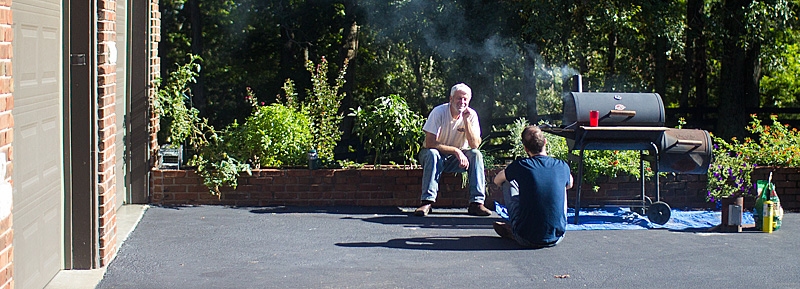
It’s hard to be romantic about standing around an immersion circulator with your loved ones, sipping bourbon and talking about life. Smoking demands patience and attention, and it turns out that soft, delicious smoldering wood goes perfectly with delicious beers and bourbon. The combination of the two frees the mind for unencumbered thought and the tongue for unfettered conversation.

But, of course, I had to be a little geeky about this. I mean, there’s still a lot at stake here.
Aaron (my Bro-Lo El Cuñado) loaned me his Char-Griller smoker for the week to smoke the various meats I intended to serve. I spent quite a bit of time reading up about smoking and, specifically, about this particular model. The site Amazing Ribs proved super-useful for this. The Char-Griller smoker is a particularly-tricky smoker to work with, in that it leaks air in various places which makes it hard to control (and, therefore, it demands a lot of attention). One of the first moves one wants to make when dealing with a smoker is to come to terms with the terribleness of hood-mounted thermometers. The Char-Griller has one built in to the top, but it (like most built-in grill thermometers) is cheap and very unreliable. So, I bought a two-probe thermometer to serve as my guidance, and resolved not to ever pay notice to the hood thermometer itself.
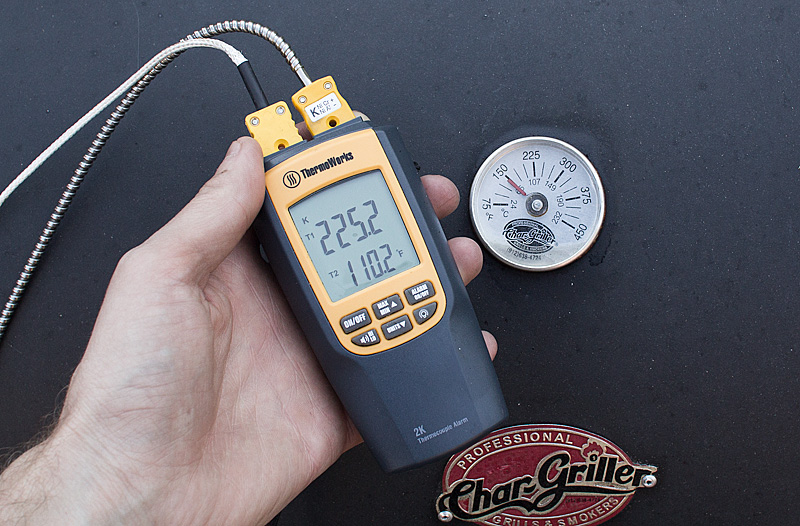
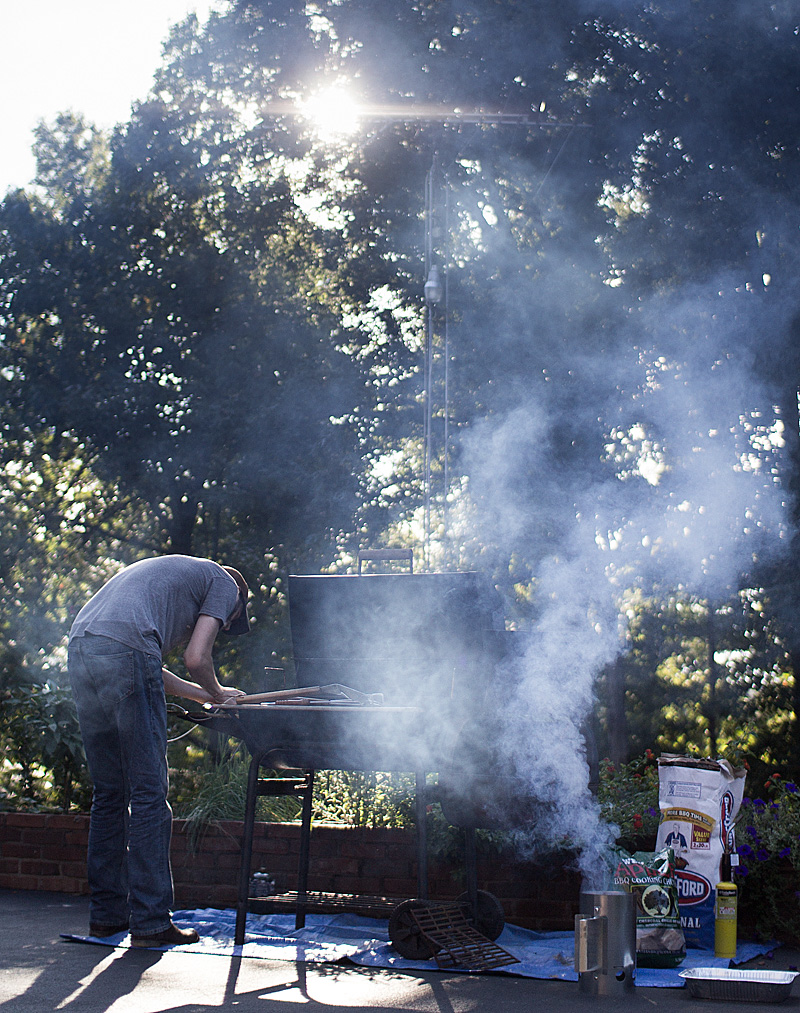
The Char-Griller has a side firebox in which one piles lit coals; the idea with it is that you can get the heat source away from the meat, helping to control temperature independently from smoke. The problem with this design is that heat wants to go up, not sideways, so heat collects in some parts of the smoker and tends to leave other parts cool. There’s no way to control this (Amazing Ribs notes some modifications that one can do to the smoker to mitigate these problems, but I had neither the time nor resources for this), so one needs to keep a close monitor of the food’s position and relative temperature throughout the cooking process.
In the photo above, the smoke is actually coming from coals placed in a chimney lighter. Compressed charcoal briquettes smoke as they light, and the smoke is acrid and chemical-y. It’s not tasty, so we don’t want it on our meat. So, I light the coals in the chimney with a yellow MAPP gas torch (you can see this to the right), and allow the chimney to sit until the smoking stops and the coals are fully-lit (covered in grey ash). This takes about a half hour to 45 minutes.
While the coals are lighting, I place unlit lump charcoal (which is hardwood, not compressed birquettes; it smokes way less) into the firebox onto a metal grate that holds the coals). I pour the lit briquettes into the firebox over the lump charcoal, and close the firebox. I could use lump charcoal for the whole shebang, which would cut way down on the acrid smoke, but I just didn’t have enough. Pouring the hot coals on top of the unlit ones means the unlit coals ignite slowly, offering me a more-constant heat source that lasts several hours. In the course of a single smoking session, I repeat this process 3-4 times.
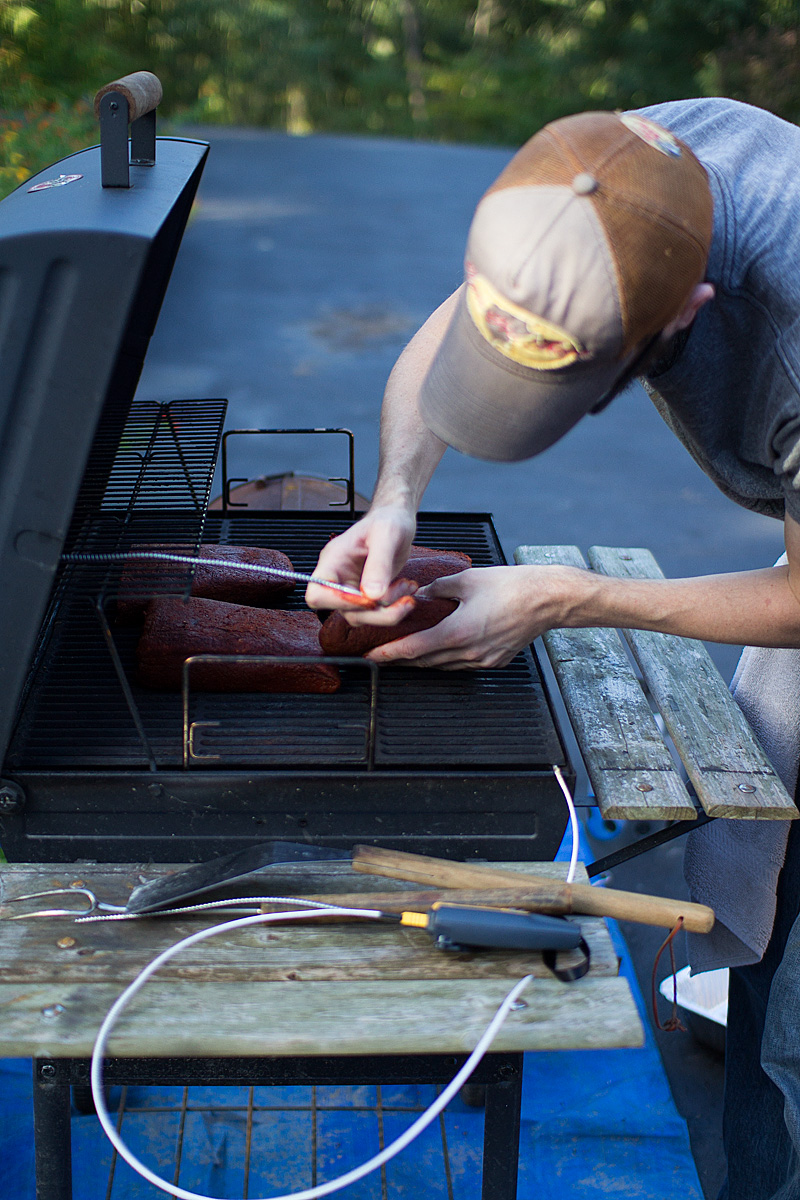
My thermometer has two probes: one to monitor the temperature of the cooking chamber (T1), and another to monitor the temperature of a meat sample (T2). I placed the chamber probe near the cooking grates, much lower than that of the hood-mounted thermometer, and waited for the chamber to come up to temperature. For most tough meats, this temperature is 225F (or as close to this as one can manage). You can see in the photo of the thermometers above that the chamber is sitting at 225F, and my meat is at 110F. Once the chamber is at temperature, the meats are added and I throw some chunk hardwood into the firebox, where the coals heat it to smoldering point. The smoke generated from hardwoods at this temperature is aromatic and soft. If the wood is allowed to reach lower temperatures, the smoke becomes bitter, and at higher temperatures the smoke turns acrid and eventually the wood ignites. It’s fortunate, then, that the flavor component and the target cooking temperature lie within the same (narrow) range. Drifting outside the range of +-15F causes things to become unstable and yields undesirable meat.
It’s popular to soak ones wood chunks in liquid to help retard them from igniting, but this is a mistake; throwing wet wood into the chamber cools the coals and causes yo-yoing temperatures. The lower initial temperature causes the smoke produced from the wood to be more bitter than it normally would, and if one is fighting wood ignition, that’s a sign that one’s coals are too hot or something else is awry with the smoker. The wood can only absorb about 5% of its weight in water anyway, so one doesn’t actually buy much from doing this.
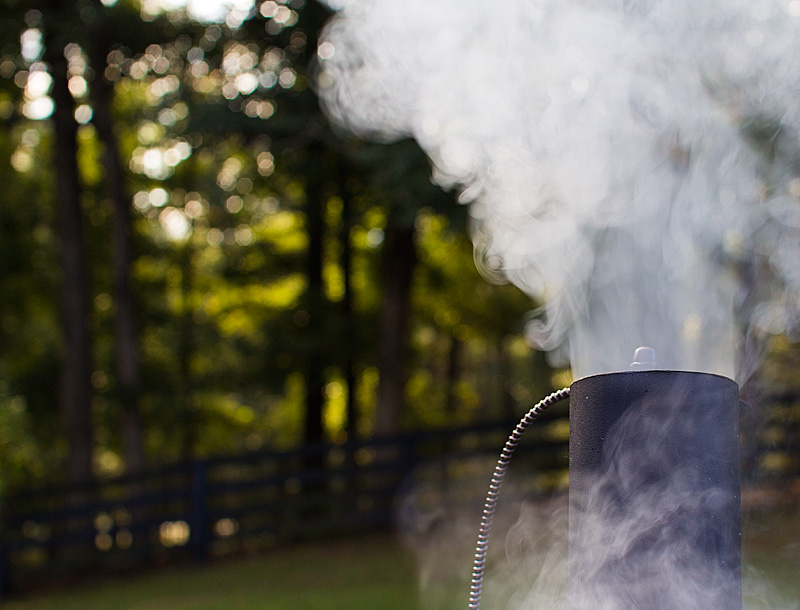
I route the other (T2) probe through the chimney of the cooking chamber and down into one of the chunks of meat, where I can monitor the temperature of the meat itself as it warms. My target for brisket and pork butt is 200F. This seems grossly over the normal temperatures one would normally cook beef or pork; while the meat itself is indeed ‘done’ at a lower temperature, the collagen inside these meats doesn’t convert to gelatin until temperatures closer to 170F-180F (so, then, smoked meats are almost always “well done”). The gelatin resulting from collagen conversion lubricates and moistens the meats, preventing it from drying out and providing the same unctuous quality that braises or stews have.
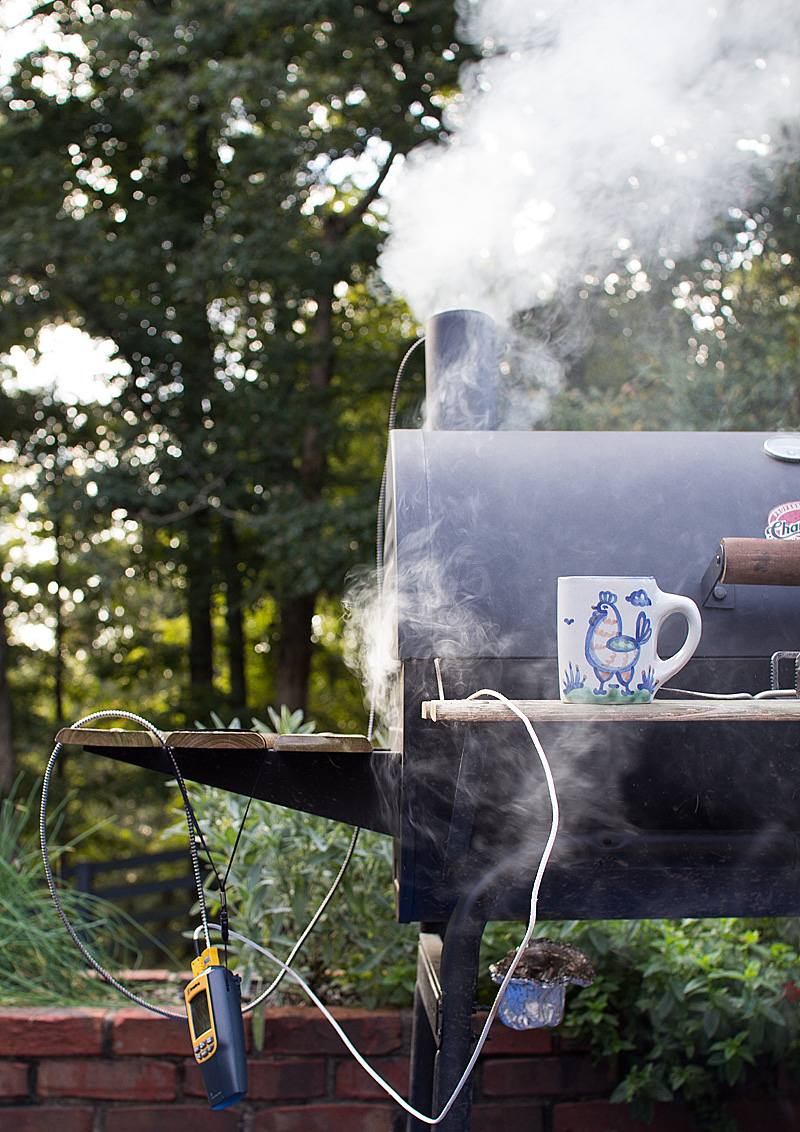
The temperature of the cooking chamber is meant to be exclusively controlled by an input vent to the firebox. One wants to fully open the vent to bring the chamber up to 225F, then choke it down to stabilize the temperature as much as possible to keep it around 225F. For this model smoker, which leaks air badly, this vent is of limited use. It is, however, the only tool one has for controlling temperature, so one needs to sit and fiddle with it every 15-30 minutes or so to maintain a steady environment. There’s a second vent on the top of the smoker chimney, but this should be left open for the most part; it does little to control temperature and is only moderately useful for controlling smoke flow.
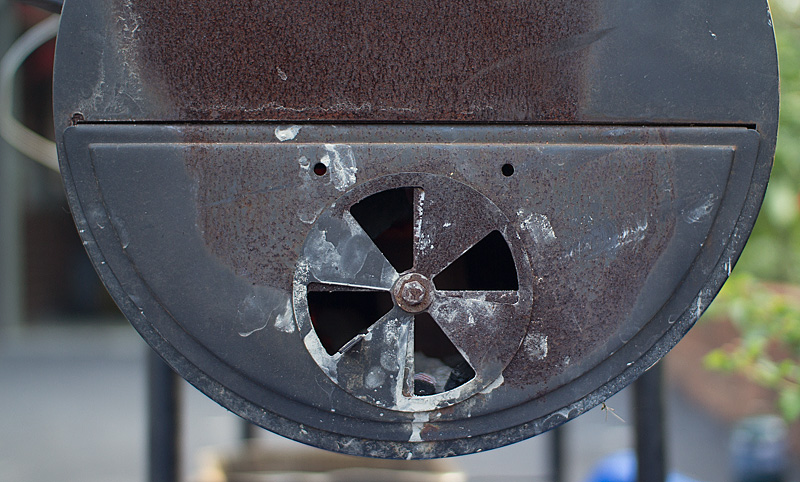
The first time I ran this smoker, I made a bit of a small mess out of it. I had trouble getting the cook chamber up to temperature, so I overloaded the firebox with coal. The ash produced by the coal filled the chamber, smothering the coals. In the end, after about 10 hours in the smoker, I needed to finish the brisket in an oven set to 225F. I was ok with this; the meat is usually fully-smoked after 5 hours (and it’s possible to over-smoke meat), so beyond that is really just a temperature game.
Meat exhibits a peculiar phenomenon when smoking; it gets up to around 160F or so then, perplexingly, seems to ‘stall’ and stop increasing in temperature for what can be several hours. This is caused by evaporative cooling; the meat effectively ‘sweats’, causing it to cool itself and cease getting hotter until the surface is completely dry. BBQ enthusiasts have developed a way to combat this: they pull the meat from the chamber and wrap it in foil (sometimes with liquid like apple juice), then continue cooking it in foil to completion. This trick is called “The Texas Crutch”; while it can speed up cook times, it also leads to a soggy bark, so champions on the BQ circuit will foil for a few hours to help the meat get up to temperature, then unfoil and cook an extra hour or so to “firm up the bark” by further evaporating absorbed surface moisture.

By the end of Wednesday I had completed the brisket and a second batch of baked beans. The beans, cooked in their individual batches, tasted way more balanced and delicious. To store them, I bagged the briskets and beans in gallon zip bags, then dropped them in a large cooler filled with ice water. We have a fridge in the basement of my parents’ house that I would be storing everything in, but I knew that dropping hot meat and beans into the fridge would cause it to take days to recover temperature, so I needed to pre-chill everything in an ice slush before storing it.
Before the night was up, I rubbed and individually-wrapped the pork butts. Pork butt is actually a shoulder roast, replete with shoulder blade and joint. Usual size for these is around 8 lbs or so, so I had bought 3. To decrease cook time and increase surface area, I cut the shoulders into two portions and boned them (BBQ enthusiasts love the moment when one can cleanly remove the bone from the shoulder roast after hours of slow-cooking, but I wanted lower cook times and more opportunity for bark).
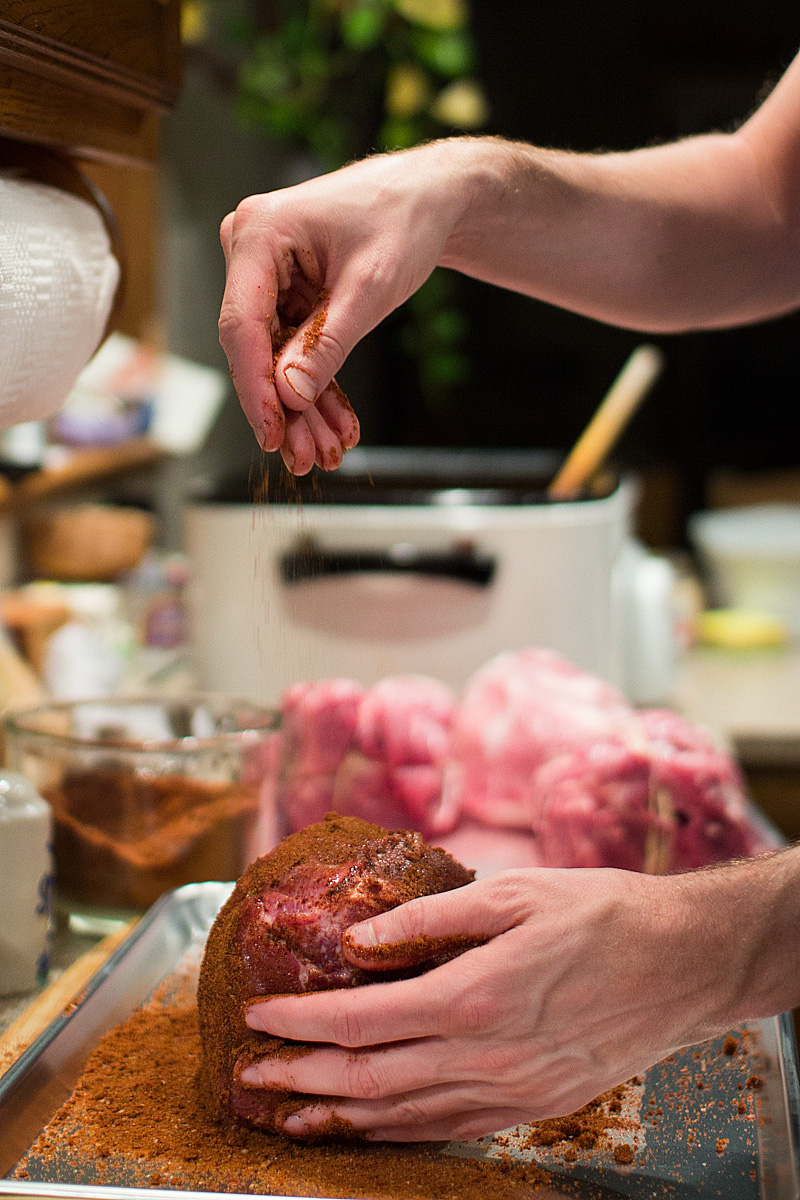
Thursday I smoked the pork butts. I made sure to raise the metal grate on which the coals rested in the firebox to allow for proper air circulation, and was less aggressive about feeding the box as it heated up. This worked much better; my patience and care was rewarded with some perfectly-cooked shoulder roasts. I again bagged the roasts right off the smoker and plunged them into an ice bath to cool; I would later re-heat these gently and shred the pork for pulled pork sandwiches.
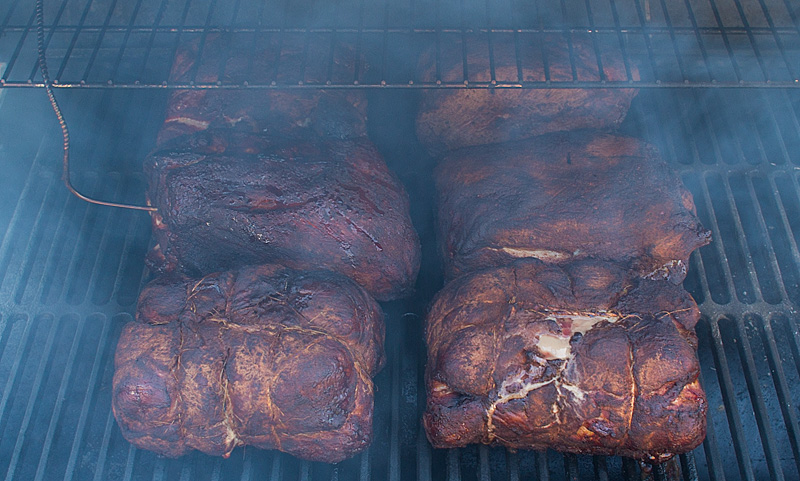
On Friday, I smoked 4 racks of pork ribs. Sarah awoke to work on the cornbread, preparing 3 half-sheet-tray’s worth (according to Deanie’s guidance). I also started preparing our cocktails; I strained the apples and spices from the bourbon, and tasted to verify that it was 100% delicious. This was mixed with lemon juice, NZ Thyme honey, Aperol, and some spice bitters I’d previously made for this. I measure this mixture into 45 pint ball jars, sealed them, and stored them in a fridge. The next day they would be topped with crisp, cold NZ cider as each guest collected a jar on their way into the forest.
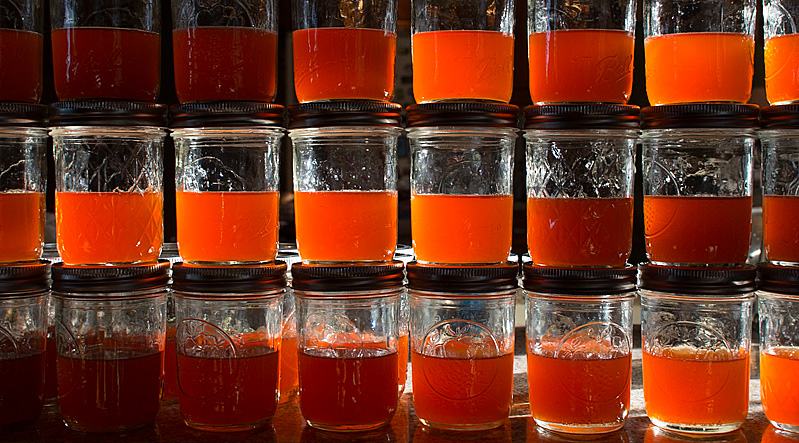
That Friday night, I made quick work (with the help of my sister Emily) chopping cabbage, red pepper, carrots, and parsley for our coleslaw. I mixed up a dressing including mayonnaise, mustard and celery seed, holding this until Saturday to dress the greens. I (and most friends of ours, and Sarah) am not crazy about the typical southern coleslaw that’s swimming in tepid watery mayonnaise, so my coleslaw was dressed only lightly.
On Saturday (“Go day”), most of the food had been prepared and was in a holding state. Starting around 11am, I started re-heating everything gently in our oven at around 180F, allowing several hours for the meats to come up to temperature before cutting/pulling them in preparation for service. I felt adamant that I wanted the smoker going on my wedding day, but the chefs at work advised against putting anything on the smoker that was high-stakes, lest I ruin my own wedding meal. So, I’d saved one rack of ribs, and Keith’s (our one pseudo-vegetarian) selection of fish. I’d gotten a couple catfish filets and a side of salmon for him.
I smoked all of these, along with about 8 oranges. The oranges were for zesting purposes; one of the stalls in the barn had been converted to a Bourbon Lounge, aided by an old couch and rolltop desk that we’d found in storage in the barn. I love smoked orange zest in Old Fashioneds. We also froze several full gallons of water in milk bottles, which we cut open and placed in a large aluminum container for hand-chipped ice for cocktails.

It was this batch of foods — smoking citrus and salmon and ribs — that we stood around on the morning/mid-afternoon of, smelling and sipping and chatting and being. Around 2pm, I pulled everything off the grill, changed into my wedding suit (a pair of custom-made Carhartt-style pants, beaten-up boots, a woolen vest, and a tie made my by my friend Lesleigh), handed the food off to a caterer we’d hired to shift the food to the barn and plate it into large communal bowls and serving platters, and got married.
It was pretty awesome.


I LOVED THIS. IT WAS SOOOO INTERESTING. THE BEST PART FOR ME WAS THE WAY YOU EXPERIENCED WALKING IN THE WOODS. I WAS THERE. THANK YOU FOR SHARING THIS.
Hey thanks so much Linda!
So happy for you! We have so many wonderful memories of events at your home. We were looking at pictures of a birthday party at the lake the other day!! Shaving cream everywhere!! Please bring Sarah to visit sometime when you are home. Tresia and Andy live here and each have 3 children. Ashley is in DC and has two. 8 grandchildren and seven are under the age of 7!! It is fun. Loved reading your story; it was if I was there! God bless you and hope to see you soon! Always, Gail
As a reader of your blog for several years now, I wanted to say Congratulations to you both. The post itself was inspiring and wonderful. Best wishes.
Aw dang, thank you so much Kelland! I really appreciate it!
Also, you have a rad name.
Congrats to you both. Sounds like it was crazy amazing.
Was there cake?
Thanks Katie! 🙂
Neither of us are big on cake, so Sarah’s mom brought a variety of pies and another guest brought (my favorite) blackberry cobbler.
Congratulations to both of you!
This was quite an experience, to be remember for life 🙂
Hey thank you so much!
You’re all sorts of fancy. I love the post and am happy for you kiddos. =) I love the labels “Made By.. This Guy”. See you soon!
This is so inspiring and amazing. Thanks for posting all the steps of the wedding. You were so well organized! I love the smoker. Congrats!
This sounded amazing! Are you going to publish your recipes at all? I currently live in France and am ALWAYS hankering for good down-home cooking, and making baked beans has been my downfall here. I’ve found a good BBQ sauce recipe, but would love some more to add to my repertoire – plus, all of my British friends are always begging me to throw more parties with “american” food! Thank you and congratulations!
Had a great time reading this. Congrats! My better half and I got married two months ago — we had food trucks cater it in a converted 1930s car repair shop. Food & ambiance make the party.